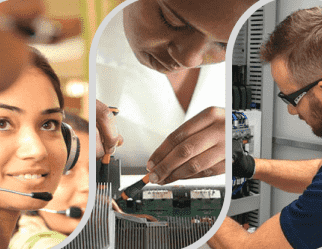There is no category of products within the security industry that evolves as fast as video surveillance. Since the introduction of the first camera network 26 years ago, many things have changed. In the past few years, the analysis of video footage through artificial intelligence and deep learning has taken off, further improving safety, security and effectiveness. For a long time, this technology was only available for businesses with large budgets, but it has now become accessible to all end users.
The introduction of the camera network in the 1990s was the first step towards the “Internet of Things”. By connecting the cameras to the internet, to an intranet or each other, it suddenly became possible to exchange data. Without this development, solutions, such as video analytics using Artificial Intelligence, would not have been possible.
Artificial Intelligence (AI) in Video Surveillance
AI and 'deep learning' play an increasingly important role in the current video surveillance market. Specialist video software capable of analysing the recorded images and deciding whether to trigger an alarm makes securing buildings even more reliable and simpler. After all, nobody wants to get out of bed in the middle of the night because of a leaf falling from a tree or a cat prowling outside. This, however, is just one of many possibilities that artificial intelligence offers. The same technology also enables, for example, vehicle license plates to be automatically registered and recognised when entering and exiting a parking lot, and this is something that has not ceased to amaze most road users. Additionally, AI can distinguish people from each other based on facial recognition or detect abnormal behaviour, which could be used for security and protection purposes. For example, suspicious behaviours in fitness centres are automatically detected and reported.
In short, AI, in association with a good camera, offers infinite possibilities and there is a suitable solution for (almost ) every situation.
What Is Artificial Intelligence Exactly?
Artificial Intelligence (AI) refers to systems or machines capable of “ thinking ” for themselves in imitating human intelligence to perform certain tasks. While performing these tasks, AI collects data and uses it for further development. The so-called “data-driven learning” is called Deep Learning. Learning based on data provided by external systems or by humans is what we call Machine Learning.
Video Analysis and Deep Learning
Artificial Intelligence not only has the ability to recognise and report programmed situations but is also able to learn from data collected by itself and draw conclusions. As far as video surveillance is concerned, this means that processes that previously required human intervention are now fully automated with the help of video management software. This process, called deep learning, has two major advantages over a human trying to complete the same task – the system may analyse images faster ( in real-time ), and it can do it more accurately. One also can't expect surveillance operators to continuously view and analyse images from several cameras while concentrating on the output. Even if it were physically possible, the process would be too tiring, with a significant risk that the human would fail to note irregularities.
Lots of Data Require Good Storage
The emergence of artificial intelligence in video surveillance means that more data than ever must be collected and analysed. After all, solutions constantly need more data to keep growing through deep learning. It is therefore essential to provide suitable storage media. On this front, many things have developed and changed in recent years, ranging from increasingly larger disc drives, which can store and process larger amounts of data faster, to suppliers who offer repair services in cases where hard drives are damaged.




